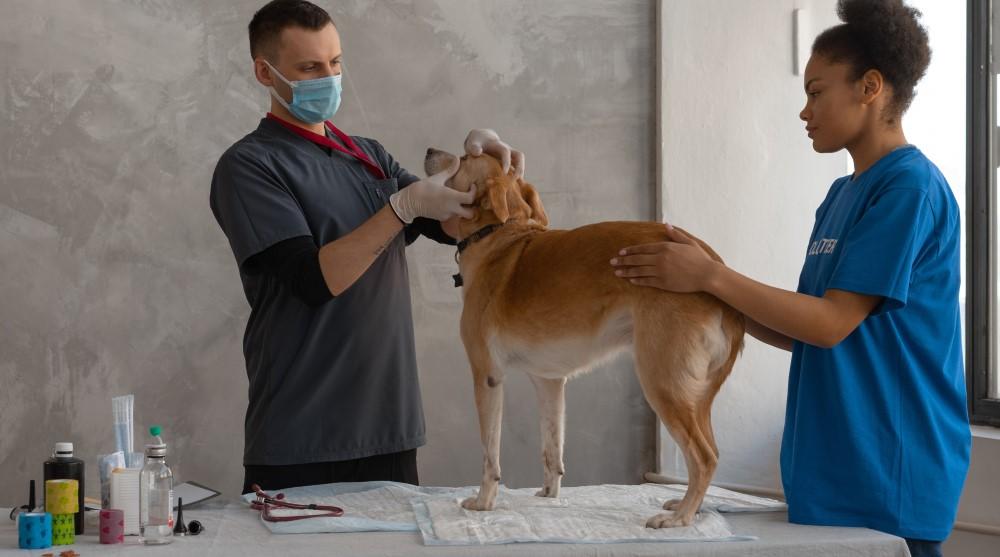Shedding: How to stop your dog’s hair everywhere
Okay, let’s talk about shedding – you know, when your dog’s fur ends up all over your clothes, furniture, and, well, everywhere. It’s a part of life with your fluffy pal, but it doesn’t have to be a hairy nightmare. In this blog, we’re going to explain why dogs shed, what makes it worse, and how you can make it better. Our goal is to help you and your dog live together more comfortably, with less fur flying around.
What is Shedding?
Shedding is when your dog loses old or damaged hair to make way for new hair. Think of it like a natural makeover for your pup. Unlike people who shed a little every day, dogs go through phases of shedding. We’ll break down those phases soon.
Understanding the Shedding Process
Shedding isn’t random – it follows a pattern. Understanding this pattern can help you control it. There are three main phases:
- Anagen Phase: This is the growth stage where new hair is sprouting, and the old hair is firmly rooted in place.
- Catagen Phase: In this transitional phase, hair growth takes a breather, and the hair follicles start to shrink.
- Telogen Phase: The resting period, where old hair finally makes its grand exit to give the new hair room to shine. This is when you see the most shedding action.
Shedding is different for every dog. It depends on their breed, age, and how healthy they are. Some dogs, like Huskies and Golden Retrievers, shed a lot. Others, like Poodles, don’t shed much at all.
The time of year and changes in hormones also affect shedding. In spring and fall, dogs often shed more as the weather shifts. Hormones, like those during pregnancy or as dogs get older, can change the shedding pattern too.

Also checkout our new post
Health and Nutrition
Believe it or not, what your dog eats plays a big part in the shedding game. A healthy diet can make a world of difference in keeping your dog’s coat shiny and shedding to a minimum. To reduce shedding, focus on providing a well-balanced diet with high-quality ingredients.
What’s in your dog’s food matters. Look for dog food rich in omega-3 and omega-6 fatty acids, which are like superfoods for their skin and coat. These nutrients help maintain a glossy, healthy coat and can reduce shedding. Foods with high protein content also support healthy fur.
To take shedding control up a notch, consider adding specific ingredients and supplements to your dog’s diet. Ingredients like salmon oil, flaxseed, and biotin can help. And if you’re looking for an extra boost, there are shedding control supplements on the market. But remember, always consult with your vet before making any changes to your dog’s diet.
Grooming Techniques
Grooming isn’t just about keeping your dog looking dapper; it’s a powerful tool in shedding management. Regular grooming can reduce the amount of loose fur floating around your home. Also, it’s an great bonding activity for you and your furbaby.
Let’s break down the basics. When it comes to brushing your pup’s hair, the frequency depends on your dog’s coat amongst other factors. For long-haired breeds, a daily brushing can work wonders. Short-haired pups might only need a weekly session. As for bathing, aim for every one to three months, depending on your dog’s activity level.
Finding the right grooming tools can make the job easier. Slicker brushes work well for removing loose fur, while deshedding tools like undercoat rakes can be a game-changer. Check the label when choosing grooming products to ensure they’re suited for your dog’s specific coat type.
Each breed might have different grooming needs, so it’s essential to understand what works best for your dog. A professional groomer can provide valuable insights into the ideal grooming routine tailored to your pup’s coat type. With regular grooming and the right tools, you’ll keep shedding at bay and have a happier, healthier dog.

Environmental Control
Your dog’s environment can significantly influence the shedding situation. Factors like indoor conditions, outdoor play, and your home’s cleanliness play a part in how much fur you find scattered around. Let’s look at how you can keep your home more fur-friendly.
A clean home goes a long way in managing shedding. Regular vacuuming, dusting, and sweeping can help keep fur at bay. Consider investing in a vacuum cleaner designed for pet hair – it can be a game-changer. Wash your dog’s bedding and your own regularly to keep those fur bunnies in check.
If you’re really serious about shedding control, you can explore air purification systems. These gadgets help remove allergens from the air, making your home more comfortable for both you and your pup. Additionally, de-shedding tools like lint rollers and sticky brushes can quickly pick up loose fur from furniture and clothing.
Managing Allergies and Skin Conditions
Allergies and skin conditions can take shedding to a whole new level. Dogs can develop allergies to certain foods, environmental factors, or even fleas. Skin issues like dermatitis or fungal infections can also lead to excessive shedding. Recognizing these problems is the first step in tackling shedding linked to allergies or skin woes.
If you suspect your dog has allergies or a skin condition, it’s essential to identify the root cause. This might involve dietary changes, avoiding allergens, or exploring medical treatments. Work closely with your vet to create a tailored plan for managing your dog’s specific condition.
Sometimes, shedding can be a sign of more significant health issues. If your dog’s shedding seems excessive, persistent, or is accompanied by other concerning symptoms like itchiness or bald patches, don’t hesitate to consult your vet. They can provide a thorough examination and offer solutions to address the underlying problems.
By understanding how environmental factors and health conditions can impact shedding, you’re better equipped to create a fur-friendly home and ensure your dog is happy, healthy, and not excessively furry. Remember, a clean home and a careful eye on your dog’s health can go a long way in shedding management.
Stress Reduction
Dogs, like humans, can experience stress, and it might surprise you to know that stress and shedding are interconnected. When your pup is stressed, it can lead to more fur flying around. Understanding this connection can help you manage both shedding and your dog’s well-being.
Just like humans, dogs benefit from stress-reduction techniques. Regular exercise is a fantastic stress-buster for your furry friend. It not only keeps them physically fit but also helps them release pent-up energy. Mental stimulation, like puzzle toys or treat-dispensing games, can also keep your dog’s mind engaged and stress levels in check.
Your dog’s environment plays a role in their stress levels. A calm and secure environment can do wonders. Provide a safe space for your dog to retreat to when they need some quiet time. Regular routines and consistent boundaries can also help reduce anxiety.

Natural Remedies
If you’re looking to tackle shedding in a more natural way, there are several remedies and alternative therapies to consider. These can be gentle yet effective in managing shedding.
Some herbal supplements and oils, like chamomile or lavender, can have a calming effect on dogs. They may help reduce stress, which, in turn, can lessen shedding. Always consult your vet before adding any supplements to your dog’s routine.
Homeopathy offers natural remedies that can be tailored to your dog’s specific needs. Homeopathic treatments are holistic and aim to address the root causes of shedding, which may include stress, allergies, or skin conditions.
While natural remedies can be beneficial, they aren’t one-size-fits-all. It’s crucial to follow safety guidelines and consult with your veterinarian. Some remedies may have side effects or interact with other medications, so professional guidance is key.
By recognizing the connection between stress and shedding, you can take steps to create a more serene environment for your pet. Exploring natural remedies and alternative therapies can offer gentle solutions to manage shedding and promote your dog’s well-being. Remember, the health and happiness of your furry friend are top priorities in the shedding battle.

When to Seek Professional Help
Sometimes, shedding can be more than just a furry nuisance; it can signal underlying health problems. It’s essential to be vigilant and recognize when shedding may be a symptom of a more significant issue. Some red flags include excessive, persistent shedding, unusual bald patches, or any changes in your dog’s skin or coat that seem out of the ordinary.
When you notice any concerning shedding patterns or other symptoms, don’t hesitate to reach out to your veterinarian. They can perform a thorough evaluation to determine if there are any health issues at play. Early detection and prompt treatment can make all the difference in managing these concerns.
Regular veterinary check-ups are your best defense against shedding issues that might be linked to health problems. These routine visits allow your vet to spot potential issues before they become more severe. They can also provide guidance on preventive measures to maintain your dog’s overall health and coat condition.
Conclusion
In the grand journey of shedding control and management, it’s time to recap what we’ve learned. Shedding is a natural part of your dog’s life, influenced by factors like breed, health, and environment. But it’s also a challenge for many pet owners. The good news is, you have the power to manage it effectively. Here are some key takeaways:
Shedding control isn’t about one magic solution; it’s about a holistic approach. This includes a well-balanced diet, grooming routines tailored to your dog’s needs, stress management, and even natural remedies when needed.
By implementing the strategies discussed in this blog, you can create a happier, healthier, and less furry home. Shedding will become a manageable part of your pet ownership experience, rather than a constant source of frustration.
Your experience and insights matter, and we’d love to hear from you. Share your shedding challenges and success stories in the comments. Your stories can inspire others and provide valuable tips for shedding management.
Spread the word! Share this blog on your social media by clicking on the buttons on bottom left corner of this blog and help others discover shedding management techniques and create harmonious homes with their pets.
For more guidance on pet care and related topics, check out our other articles, products, and services. We’re here to support you on your pet ownership journey, every step of the way. Thank you for joining us on this shedding adventure!





